 The Praça do Comércio, also known as the Terreiro do Paço or, as it used to be called by the English, 'Black Horse Square'. Linger here for ten minutes to photograph the trams and the 18th-century architecture of the square, part of the reconstruction of the city after the 1755 earthquake. Where the Rua Aurea meets the square is where King Carlos of Portugal and his Crown Prince were assassinated as they passed in their carriage on 1 February, 1908, an event which presaged the Portuguese Revolution of 1910 and the establishment of a Republic. You can divert for a few minutes by ascending the Arco da Rua Augusta, which has fine views, though you will have to pay separately to do so.
The Praça do Comércio, also known as the Terreiro do Paço or, as it used to be called by the English, 'Black Horse Square'. Linger here for ten minutes to photograph the trams and the 18th-century architecture of the square, part of the reconstruction of the city after the 1755 earthquake. Where the Rua Aurea meets the square is where King Carlos of Portugal and his Crown Prince were assassinated as they passed in their carriage on 1 February, 1908, an event which presaged the Portuguese Revolution of 1910 and the establishment of a Republic. You can divert for a few minutes by ascending the Arco da Rua Augusta, which has fine views, though you will have to pay separately to do so.
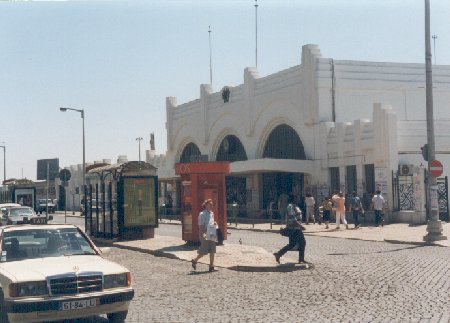
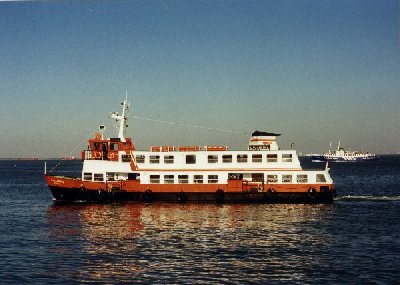
L. to R.:-The Sul e Sueste ferry terminal; a typical Lisbon ferry.
 Walk past the equestrian statue of King José I towards the river Tagus. The waterfront was for many years despoiled by works connected with the much-delayed Metro connection to Terreiro do Paço, which was plagued by delays and tunnel leakage. The station finally opened in December 2007. Slightly to the left, at the river's edge is the white Estação do Sul e Sueste (ferry station), formerly for services to Barreiro, but now supplanted by the adjacent modern terminal to its left. (Time elapsed, 35 mins).
Walk past the equestrian statue of King José I towards the river Tagus. The waterfront was for many years despoiled by works connected with the much-delayed Metro connection to Terreiro do Paço, which was plagued by delays and tunnel leakage. The station finally opened in December 2007. Slightly to the left, at the river's edge is the white Estação do Sul e Sueste (ferry station), formerly for services to Barreiro, but now supplanted by the adjacent modern terminal to its left. (Time elapsed, 35 mins).
 To get to the ferry at Cais do Sodré, either catch the Metro at Terreiro do Paço (change at Baixa-Chiado) or, just as quickly, leave the Cais da Alfândega and turn immediately left, along the river edge, with the Pr. do Comércio to your right. This walkway normally affords good views of the ferry services and leads you to the Cais do Sodré railway and ferry station from the latter of which all the Cacilhas services operate. If you take the trip to Cacilhas (about 10 mins each way and a frequent service), there is a bus station immediately outside the ferry terminal, as well as numerous cafés and restaurants along the waterfront. Opposite the ferry the MTS metro station provides connections with the Fertagus railway at Pragal or Corroios. Also, close to the Cacilhas terminal are the former ship-repair yards of Lisnave, now sadly quiet. See the Lisbon Ferries page for more details. NB The Viva Viagem ticket bought at Metro stations is NOT valid on TransTejo ferries; you will need to buy a ferrry ticket from the ticket office or machines; your Viva Viagem ticket issued by the ferry station will have a "TT" prefix to its number.
To get to the ferry at Cais do Sodré, either catch the Metro at Terreiro do Paço (change at Baixa-Chiado) or, just as quickly, leave the Cais da Alfândega and turn immediately left, along the river edge, with the Pr. do Comércio to your right. This walkway normally affords good views of the ferry services and leads you to the Cais do Sodré railway and ferry station from the latter of which all the Cacilhas services operate. If you take the trip to Cacilhas (about 10 mins each way and a frequent service), there is a bus station immediately outside the ferry terminal, as well as numerous cafés and restaurants along the waterfront. Opposite the ferry the MTS metro station provides connections with the Fertagus railway at Pragal or Corroios. Also, close to the Cacilhas terminal are the former ship-repair yards of Lisnave, now sadly quiet. See the Lisbon Ferries page for more details. NB The Viva Viagem ticket bought at Metro stations is NOT valid on TransTejo ferries; you will need to buy a ferrry ticket from the ticket office or machines; your Viva Viagem ticket issued by the ferry station will have a "TT" prefix to its number.
Cais do Sodré is a hub for five modes of transport; train, Metro, bus, tram and ferry. For rail services along the Atlantic coast to Estoril and Cascais you will need to allow up to a couple of hours to make the return journey all the way to Cascais (45 mins trip each way, plus waiting time). However, if you catch a stopping train to Belém, (check the monitors, as some trains do not stop at Belém), you can get to this historic suburb in just 8 minutes. Just buy a single ticket from the machines, as you can return to Lisbon by tram route 15, and return rail tickets are no cheaper than two singles anyway. (This railway line also uses Viva Viagem tickets but the ones you buy in the Metro, which have a number prefixed by "ML", are NOT valid on the trains, where a ticket prefixed "CP" is required. (Elapsed time of this trip, to Belém, including waiting, 1hr 10mins).
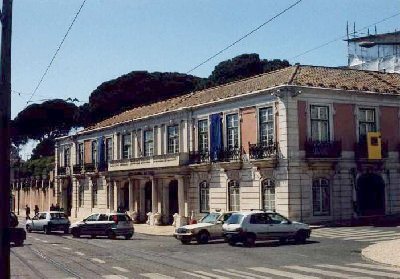
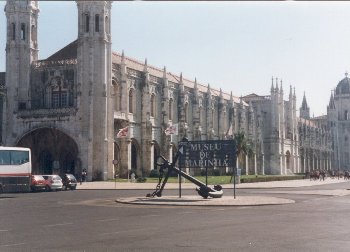
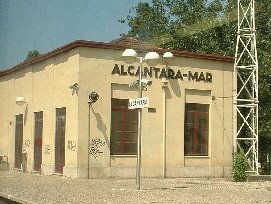
L. to R.:-The Museu dos Coches; the Museu Naval; Alcântara-Mar
station on the Cascais line.
 At Belém station, cross the line via the bridge and exit the station, heading forward in the direction away from Lisbon. On the left (riverside) of the railway lines is the Museu da Electricidade (Electricity Museum) and Museu de Arte, Arquitetura e Tecnologia (opened 2016), whose entrances are on the river-front. On the landward side of Belém station is the 2015 huge extension to the Museu dos Coches. You can get a ticket to both this new building and the historic building of the Museu dos Coches or individual tickets to each premises.
At Belém station, cross the line via the bridge and exit the station, heading forward in the direction away from Lisbon. On the left (riverside) of the railway lines is the Museu da Electricidade (Electricity Museum) and Museu de Arte, Arquitetura e Tecnologia (opened 2016), whose entrances are on the river-front. On the landward side of Belém station is the 2015 huge extension to the Museu dos Coches. You can get a ticket to both this new building and the historic building of the Museu dos Coches or individual tickets to each premises.
If you keep to the right (landward side) of the railway and pass through the ornamental garden, with its statue on a tall column of Afonso de Albuquerque, a 16th-century Portuguese explorer of the Middle-East, and to the right you will see the pink presidential palace, with its ceremonial guards outside. As you face the palace, with your back to the railway, the historic building of the Museu dos Coches (Historic Horse-Drawn Coaches Museum) can be found at the left-hand corner of the palace grounds. (Elapsed time 1hr 20 mins).
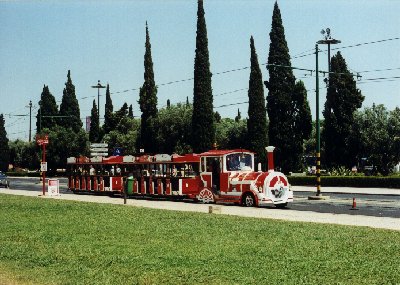
Right: The Comboio de Belém road train.
If you have a spare 45 minutes, you can make a rapid visit to see the Museu dos Coches' exhibits. A further ten minutes walk away from the railway station brings you to the historic Jerónimos monastery, at the far end of which is the Museu de Marinha (Maritime Museum). You would need a couple of hours minimum to see all of the museum. If you do not have the time, just look at the few outdoor exhibits and have a drink in the Museum café, which is accessible without going into the museum itself. Then, (elapsed time, assuming 20 mins in the cafe, = 2hrs 10 mins), continue 100 yards
past the museum to the tram stop (service 15) on the opposite side of the road to the museum, at the side of the massive Centro Cultural de Belém. Alternatively, enter the Centro Cultural and enjoy a drink in the open-air roof-top café, from where you can watch the trains speed by on the Cascais Line, below. If you want to explore the area more fully, you can hop on the Comboio de Belém, a tourist road train which is remarkably cheap for a trip around the whole area. Its terminus is outside the Jerónimos monastery.
 Travel on the no. 15 route tram back to Lisbon from Belém all the way to its terminus, Praça da Figueira, in central Lisbon. (Alternatively, get off at Santo Amaro and visit the Carris Transport Museum. The museum is exactly where the tall bridge supports cross the tram route). The tram service is operated by a mixture of articulated, air-conditioned trams and 'remodelados', four-wheel trams. The route takes you via Alcântara, where the docks can be seen to the right.The tram route from Alcântara runs alongside the Cascais line railway to Cais do Sodré, where it turns slightly inland before emerging in the Pr. do Comércio, before it turns left up the Rua da Prata, to its terminus in Pr. da Figueira. (Elapsed time c. 2hrs 45mins).
Travel on the no. 15 route tram back to Lisbon from Belém all the way to its terminus, Praça da Figueira, in central Lisbon. (Alternatively, get off at Santo Amaro and visit the Carris Transport Museum. The museum is exactly where the tall bridge supports cross the tram route). The tram service is operated by a mixture of articulated, air-conditioned trams and 'remodelados', four-wheel trams. The route takes you via Alcântara, where the docks can be seen to the right.The tram route from Alcântara runs alongside the Cascais line railway to Cais do Sodré, where it turns slightly inland before emerging in the Pr. do Comércio, before it turns left up the Rua da Prata, to its terminus in Pr. da Figueira. (Elapsed time c. 2hrs 45mins).
If you are feeling hungry, go down the adjacent Rua dos Correeiros, where there are numerous cheap but generally excellent, Portuguese restaurants- see the Eating and Drinking
page of this site for details. If you are hungry but have less time, get off the tram in the Pr. do Comércio and head for the Leitaria Campesina (junction of Rua dos Correeiros and Rua S. Nicolau) or Café Pombalino (rua dos Fanqueiros) for a snack (again, see the Eating page). If you stop for an hour for lunch, the elapsed time will be 3hrs 45mins.
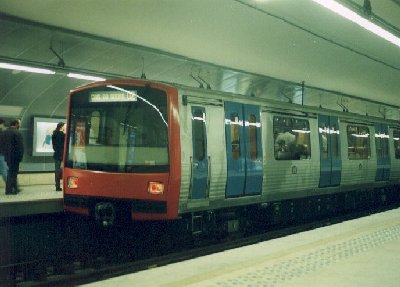
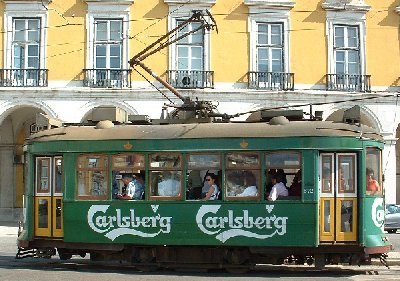
A Metro train; a 'remodelado' tram.
 After lunch, you can take life more easily and have a sit down on a train and the Metro. To do this, first enter the Rossio Metro station which is accessible from the north-west corner of the Pr. da Figueira, or from the east side of Rossio itself. Catch a north-bound Green Line train.
After lunch, you can take life more easily and have a sit down on a train and the Metro. To do this, first enter the Rossio Metro station which is accessible from the north-west corner of the Pr. da Figueira, or from the east side of Rossio itself. Catch a north-bound Green Line train.
However, you will need to get off at Alameda and change onto the Red Line to its terminal station at Oriente. NB It is a longish walk between the two lines! (Elapsed time to Oriente, c.4hrs 15mins). Follow the signs (often just pictograms of a train) to the Oriente main railway station; the route is all under cover, through a shopping mall. The station architecture is striking and you can observe its train services. Return via the Metro to Entrecampos.
If time is limited, omit the trip to Oriente and just catch a Metro to Entrecampos.
 At the Entrecampos CP railway-station, either simply observe the frequent suburban train movements, including double-deck CP and Fertagus stock, or if you have 90mins, buy a return ticket for the Fertagus line across the Tagus river to Pragal. This will take you in modern double-deck EMUs across the Ponte 25 de Abril (suspension bridge) from Lisbon to the south bank of the Tagus; the bridge crossing is well-worthwhile for the views alone (the docks to the left, Belém to the right).
At the Entrecampos CP railway-station, either simply observe the frequent suburban train movements, including double-deck CP and Fertagus stock, or if you have 90mins, buy a return ticket for the Fertagus line across the Tagus river to Pragal. This will take you in modern double-deck EMUs across the Ponte 25 de Abril (suspension bridge) from Lisbon to the south bank of the Tagus; the bridge crossing is well-worthwhile for the views alone (the docks to the left, Belém to the right).
Just outside Pragal station, is the Metro do Sul do Tejo tram service. Services are frequent and you can get to Universidade (Caparica) and back in half an hour. Alternatively you can catch the metro to Cacilhas and return to Lisbon from there by ferry. If you have time, Pragal, like all the Fertagus stations, is light and airy and has a café and supermarket. By the time you get back to Entrecampos, the elapsed time will be c.6hrs.
A longer alternative to the cross-Tagus trip from Entrecampos is a rail trip from the same station to Sintra, where, apart from the historic town, you may be able to time your visit to coincide with the operations of the Sintra-Atlântico tramway, now run by Sintra Council.
From Entrecampos, you can either catch a train back to Oriente and then the Metro from there to Rossio, via Alameda, or you can catch the Yellow Line Metro at Entrecampos, to Rossio via Campo Grande. At Campo Grande, you will change onto the Green Line. You may wish to linger at Campo Grande to watch operations at the busy suburban bus interchange beneath the Metro station bridge and to view the striking José Alvalade stadium of Sporting Lisbon football club, which replaced an older but also impressive stadium for Euro 2004. Many Lisbon suburban bus operators may be observed here. (Elapsed time, assuming a stop at the bus station, c.7hrs 15mins).

 Alight at Rossio and take a well-earned rest at one of the many cafés in Rossio or in the adjacent Pr. da Figueira. Then
(elapsed time 8hrs), take a five-minute walk across Rossio, with the river behind you in the distance, to the Rossio railway station on the left. The neo-Manueline architecture of the station is striking; frequent services run from here to Sintra from a higher level within the building. Walk past the station, 100 metres into the Praça dos Restauradores, where the palace on the left is the main tourist office, the Palácio
Foz. (There is an excellent Italian "Veneziana" ice-cream parlour in the left-hand corner of the square as you face the tourist office!). Immediately next door to the tourist
office is the bottom of the Glória funicular, one of three survivors still operating an intensive service in Lisbon. Sadly, these days the funiculars are covered in graffiti. (Alternatively, there is another funicular trip, on the other side of the Avenida da Liberdade where the Lavra funicular operates). Your Viva pass is valid on it and the journey only takes a couple of minutes.
Linger at the top and look over the city from the gardens. (Elapsed time c.8hrs 30mins).
Alight at Rossio and take a well-earned rest at one of the many cafés in Rossio or in the adjacent Pr. da Figueira. Then
(elapsed time 8hrs), take a five-minute walk across Rossio, with the river behind you in the distance, to the Rossio railway station on the left. The neo-Manueline architecture of the station is striking; frequent services run from here to Sintra from a higher level within the building. Walk past the station, 100 metres into the Praça dos Restauradores, where the palace on the left is the main tourist office, the Palácio
Foz. (There is an excellent Italian "Veneziana" ice-cream parlour in the left-hand corner of the square as you face the tourist office!). Immediately next door to the tourist
office is the bottom of the Glória funicular, one of three survivors still operating an intensive service in Lisbon. Sadly, these days the funiculars are covered in graffiti. (Alternatively, there is another funicular trip, on the other side of the Avenida da Liberdade where the Lavra funicular operates). Your Viva pass is valid on it and the journey only takes a couple of minutes.
Linger at the top and look over the city from the gardens. (Elapsed time c.8hrs 30mins).
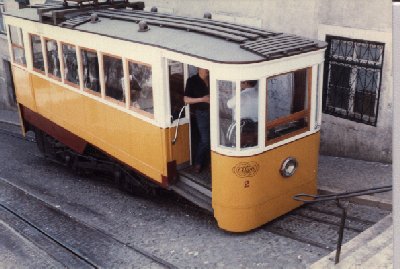
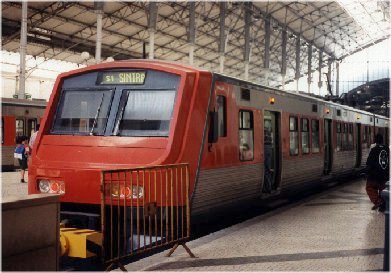
L. to R.:- The Glória funicular; a Sintra Line EMU.
Returning to the Avenida da Liberdade, head back towards the river along the Rua Aurea, till you reach the Baixa-Chiado metro station off the street to your right. Walk through the subway and up the multiple escalators to the Chiado. Emerging from the subway, walk down the Rua Garrett, at the bottom of which turn left into the Rua do
Carmo and you will be back at the Elevador de Santa Justa once more. Alternatively just go back down the Metro escalators to Baixa-Chiado station and keep walking until you end up in the Rua do Crucifixo in the Baixa, close to the Elevador. The whole trip will have taken you about 9hrs. You may be tired afterwards but you will have seen
something of Lisbon's trams, ferries, funiculars, bridges, Metro and railways, as well as the south bank of the Tagus. If you want to experience Lisbon's buses, your Carris pass will take you anywhere within the city boundaries. You could catch one to Lisbon airport, for example, to see the range of aircraft which serve the city.
If the above itinerary is too hectic or the weather is bad, you could always retreat to the Carris Transport Museum, located on
tram route 15 at Santo Amaro, half way to Belém.
More Leisurely Exploration
For a more leisurely exploration of Lisbon's transport system, you may find the other sections of the Luso Pages useful- all are listed in the Links, at the top left of this page.
Copyright: ©
Compiled by John Laidlar

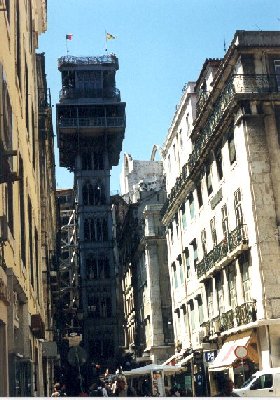
 18 October 2016
18 October 2016


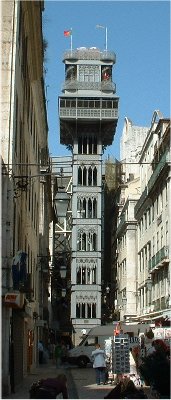
 Amongst the many available maps of Lisbon, the Berndtson & Berndtson Lisboa map (ISBN 3-929811-50-2) is very practical as it is laminated and thus can bear continuous folding and unfolding; it also shows Lisbon's Metro stations. However, for a map showing bus and tram routes, the Kümmerly and Frey Lissabon map (ISBN 3-25902-071-3) is excellent. Carris itself produces a free route map, which is of course more authoritative but much less detailed. Unfortunately, the Carris map, which regularly changes format, is frequently out of print and the 2009 version is printed in very small type which is very impractical. However, the network map is on their
Amongst the many available maps of Lisbon, the Berndtson & Berndtson Lisboa map (ISBN 3-929811-50-2) is very practical as it is laminated and thus can bear continuous folding and unfolding; it also shows Lisbon's Metro stations. However, for a map showing bus and tram routes, the Kümmerly and Frey Lissabon map (ISBN 3-25902-071-3) is excellent. Carris itself produces a free route map, which is of course more authoritative but much less detailed. Unfortunately, the Carris map, which regularly changes format, is frequently out of print and the 2009 version is printed in very small type which is very impractical. However, the network map is on their  Use your newly acquired pass to take you up the Elevador de Santa Justa. From
the viewing gallery at the top, use your map to get your bearings. You will see Rossio square immediately to the north-east, with Rossio station just off its far left corner. To the east is the Castelo de S. Jorge on the hilltop and to the south is the Baixa area of regular streets which lead down to the river Tagus. (Elapsed time 10 mins).
The walkway at the top, which was the reason for the elevator's construction, was closed for some six years from 1999 but in early 2006 it was re-opened. So, if you have ten minutes to spare, take the walkway off the upper level of the elevator and make your way, past the Carmo convent, left in ruins since the 1755 earthquake (on your right), via the Largo do Carmo, scene of Prime-Minister Caetano's surrender during the 1974 revolution, left into the Calçada do Sacramento, left again into the fashionable Rua Garrett, and left again into the Rua Carmo, to return to the base of the elevator. Alternatively, if you use the elevator itself to descend, turn right into the Rua de Sta Justa, then first right into the Rua Aurea (Rua de Ouro). Walk for about five minutes (elapsed time 20 mins) till you reach...
Use your newly acquired pass to take you up the Elevador de Santa Justa. From
the viewing gallery at the top, use your map to get your bearings. You will see Rossio square immediately to the north-east, with Rossio station just off its far left corner. To the east is the Castelo de S. Jorge on the hilltop and to the south is the Baixa area of regular streets which lead down to the river Tagus. (Elapsed time 10 mins).
The walkway at the top, which was the reason for the elevator's construction, was closed for some six years from 1999 but in early 2006 it was re-opened. So, if you have ten minutes to spare, take the walkway off the upper level of the elevator and make your way, past the Carmo convent, left in ruins since the 1755 earthquake (on your right), via the Largo do Carmo, scene of Prime-Minister Caetano's surrender during the 1974 revolution, left into the Calçada do Sacramento, left again into the fashionable Rua Garrett, and left again into the Rua Carmo, to return to the base of the elevator. Alternatively, if you use the elevator itself to descend, turn right into the Rua de Sta Justa, then first right into the Rua Aurea (Rua de Ouro). Walk for about five minutes (elapsed time 20 mins) till you reach...
 The Praça do Comércio, also known as the Terreiro do Paço or, as it used to be called by the English, 'Black Horse Square'. Linger here for ten minutes to photograph the trams and the 18th-century architecture of the square, part of the reconstruction of the city after the 1755 earthquake. Where the Rua Aurea meets the square is where King Carlos of Portugal and his Crown Prince were assassinated as they passed in their carriage on 1 February, 1908, an event which presaged the Portuguese Revolution of 1910 and the establishment of a Republic. You can divert for a few minutes by ascending the Arco da Rua Augusta, which has fine views, though you will have to pay separately to do so.
The Praça do Comércio, also known as the Terreiro do Paço or, as it used to be called by the English, 'Black Horse Square'. Linger here for ten minutes to photograph the trams and the 18th-century architecture of the square, part of the reconstruction of the city after the 1755 earthquake. Where the Rua Aurea meets the square is where King Carlos of Portugal and his Crown Prince were assassinated as they passed in their carriage on 1 February, 1908, an event which presaged the Portuguese Revolution of 1910 and the establishment of a Republic. You can divert for a few minutes by ascending the Arco da Rua Augusta, which has fine views, though you will have to pay separately to do so.


 Walk past the equestrian statue of King José I towards the river Tagus. The waterfront was for many years despoiled by works connected with the much-delayed Metro connection to Terreiro do Paço, which was plagued by delays and tunnel leakage. The station finally opened in December 2007. Slightly to the left, at the river's edge is the white Estação do Sul e Sueste (ferry station), formerly for services to Barreiro, but now supplanted by the adjacent modern terminal to its left. (Time elapsed, 35 mins).
Walk past the equestrian statue of King José I towards the river Tagus. The waterfront was for many years despoiled by works connected with the much-delayed Metro connection to Terreiro do Paço, which was plagued by delays and tunnel leakage. The station finally opened in December 2007. Slightly to the left, at the river's edge is the white Estação do Sul e Sueste (ferry station), formerly for services to Barreiro, but now supplanted by the adjacent modern terminal to its left. (Time elapsed, 35 mins).
 To get to the ferry at Cais do Sodré, either catch the Metro at Terreiro do Paço (change at Baixa-Chiado) or, just as quickly, leave the Cais da Alfândega and turn immediately left, along the river edge, with the Pr. do Comércio to your right. This walkway normally affords good views of the ferry services and leads you to the Cais do Sodré railway and ferry station from the latter of which all the Cacilhas services operate. If you take the trip to Cacilhas (about 10 mins each way and a frequent service), there is a bus station immediately outside the ferry terminal, as well as numerous cafés and restaurants along the waterfront. Opposite the ferry the MTS metro station provides connections with the Fertagus railway at Pragal or Corroios. Also, close to the Cacilhas terminal are the former ship-repair yards of Lisnave, now sadly quiet. See the
To get to the ferry at Cais do Sodré, either catch the Metro at Terreiro do Paço (change at Baixa-Chiado) or, just as quickly, leave the Cais da Alfândega and turn immediately left, along the river edge, with the Pr. do Comércio to your right. This walkway normally affords good views of the ferry services and leads you to the Cais do Sodré railway and ferry station from the latter of which all the Cacilhas services operate. If you take the trip to Cacilhas (about 10 mins each way and a frequent service), there is a bus station immediately outside the ferry terminal, as well as numerous cafés and restaurants along the waterfront. Opposite the ferry the MTS metro station provides connections with the Fertagus railway at Pragal or Corroios. Also, close to the Cacilhas terminal are the former ship-repair yards of Lisnave, now sadly quiet. See the 


 At Belém station, cross the line via the bridge and exit the station, heading forward in the direction away from Lisbon. On the left (riverside) of the railway lines is the Museu da Electricidade (Electricity Museum) and Museu de Arte, Arquitetura e Tecnologia (opened 2016), whose entrances are on the river-front. On the landward side of Belém station is the 2015 huge extension to the Museu dos Coches. You can get a ticket to both this new building and the historic building of the Museu dos Coches or individual tickets to each premises.
At Belém station, cross the line via the bridge and exit the station, heading forward in the direction away from Lisbon. On the left (riverside) of the railway lines is the Museu da Electricidade (Electricity Museum) and Museu de Arte, Arquitetura e Tecnologia (opened 2016), whose entrances are on the river-front. On the landward side of Belém station is the 2015 huge extension to the Museu dos Coches. You can get a ticket to both this new building and the historic building of the Museu dos Coches or individual tickets to each premises.

 Travel on the no. 15 route tram back to Lisbon from Belém all the way to its terminus, Praça da Figueira, in central Lisbon. (Alternatively, get off at Santo Amaro and visit the
Travel on the no. 15 route tram back to Lisbon from Belém all the way to its terminus, Praça da Figueira, in central Lisbon. (Alternatively, get off at Santo Amaro and visit the 

 After lunch, you can take life more easily and have a sit down on a train and the Metro. To do this, first enter the Rossio Metro station which is accessible from the north-west corner of the Pr. da Figueira, or from the east side of Rossio itself. Catch a north-bound Green Line train.
After lunch, you can take life more easily and have a sit down on a train and the Metro. To do this, first enter the Rossio Metro station which is accessible from the north-west corner of the Pr. da Figueira, or from the east side of Rossio itself. Catch a north-bound Green Line train.  At the Entrecampos CP railway-station, either simply observe the frequent suburban train movements, including double-deck CP and Fertagus stock, or if you have 90mins, buy a return ticket for the Fertagus line across the Tagus river to Pragal. This will take you in modern double-deck EMUs across the Ponte 25 de Abril (suspension bridge) from Lisbon to the south bank of the Tagus; the bridge crossing is well-worthwhile for the views alone (the docks to the left, Belém to the right).
At the Entrecampos CP railway-station, either simply observe the frequent suburban train movements, including double-deck CP and Fertagus stock, or if you have 90mins, buy a return ticket for the Fertagus line across the Tagus river to Pragal. This will take you in modern double-deck EMUs across the Ponte 25 de Abril (suspension bridge) from Lisbon to the south bank of the Tagus; the bridge crossing is well-worthwhile for the views alone (the docks to the left, Belém to the right).
 Alight at Rossio and take a well-earned rest at one of the many cafés in Rossio or in the adjacent Pr. da Figueira. Then
(elapsed time 8hrs), take a five-minute walk across Rossio, with the river behind you in the distance, to the Rossio railway station on the left. The neo-Manueline architecture of the station is striking; frequent services run from here to Sintra from a higher level within the building. Walk past the station, 100 metres into the Praça dos Restauradores, where the palace on the left is the main tourist office, the Palácio
Foz. (There is an excellent Italian "Veneziana" ice-cream parlour in the left-hand corner of the square as you face the tourist office!). Immediately next door to the tourist
office is the bottom of the Glória
Alight at Rossio and take a well-earned rest at one of the many cafés in Rossio or in the adjacent Pr. da Figueira. Then
(elapsed time 8hrs), take a five-minute walk across Rossio, with the river behind you in the distance, to the Rossio railway station on the left. The neo-Manueline architecture of the station is striking; frequent services run from here to Sintra from a higher level within the building. Walk past the station, 100 metres into the Praça dos Restauradores, where the palace on the left is the main tourist office, the Palácio
Foz. (There is an excellent Italian "Veneziana" ice-cream parlour in the left-hand corner of the square as you face the tourist office!). Immediately next door to the tourist
office is the bottom of the Glória 
